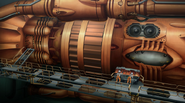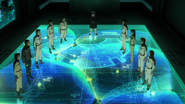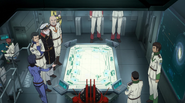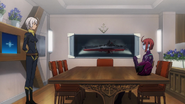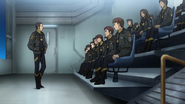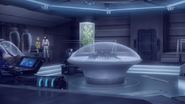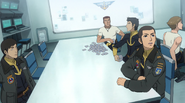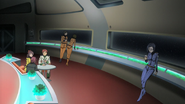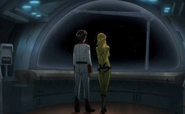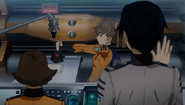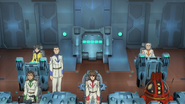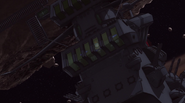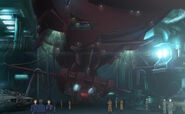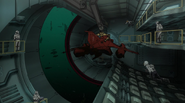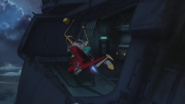- This article describes the space battleship Yamato as depicted in Space Battleship Yamato 2199 and its spinoffs and sequels. For information on other vessels bearing the name Yamato in this series or in other series or movies, see the Yamato disambiguation page.
The Yamato (BBY-01) (ヤマト, Yamato) is a United Nations Cosmo Navy space battleship. First conceived as an evacuation ship for survivors fleeing the Garmillas-Earth War, an unexpected gift of highly advanced wave motion technology from the planet Iscandar convinces the leadership of the United Nations Cosmo Force to use it in a more ambitious and dangerous plan to save all life on Earth from extinction. During its first year of service, Yamato and its crew also become involved in the Garmillas Civil War, bring an end to the war with the Great Garmillas Empire, discover the legendary world Shambleau, and make first human contact with the Gatlantis Empire. Three years later, the ship fought in a number of important battles of the Gatlantis-Earth War during its journey to Terezart.
Armaments and Technical Specifications
Yamato's offensive and defensive systems make it Earth's most formidable warship at the time of its launch in 2199. Shock cannon turrets mounted along the length of the upper hull provide its primary conventional firepower, firing high energy positron beams, type-3 shells, or a combination of the two that can destroy many smaller Garmillan and Gatlantean vessels in a single shot[5] ("Escape from the Jupiter Sphere", "The Sun Sets on Pluto"). Missiles and torpedo launchers can fire in all directions ("Point of No Return", "Over the Black Light"). Rapid fire anti-aircraft batteries on the port and starboard sides provide added protection around the ship's bridge tower ("Toward a Sea of Stars", "Under a Rainbow Sun"). With a hull that can safely absorb significant damage, Yamato becomes the battlefield equal of the Garmillas Imperial Astro Fleet's Zoelguut-Class super dreadnought ("Point of No Return", "Under a Rainbow Sun"). The ship is also equipped with an Asteroid Ring Generated Offense (ARGO) System[6], which uses small magnetically controlled rocket anchors to grab and manipulate space debris into spinning rings or a protective covering. As part of an earlier mission plan that was eventually replaced, ARGO was neglected during Yamato's first year of service, but it was left in place and first deployed in combat in late 2202 ("Clash! Yamato vs. Andromeda").

Yamato fires its wave motion gun.
The addition of wave motion energy elevates it beyond almost all other adversaries. Until late 2199 and again from the end of 2202, the ship is equipped with a wave motion gun built into its bow. A single blast of the gun can vaporize targets as big as continents ("Escape from the Jupiter Sphere", "Wish Upon a Star"). However, the gun requires time to build to full capacity, and additional minutes afterward to recharge, leaving Yamato immobile and unable use its other weapons, and limiting its effectiveness to larger and relatively stationary objects ("Graveyard of the Universe", "Over the Black Light"). The wave motion engine can also generate a durable wave motion shield enveloping the ship that can deflect very high energy hits and sustained attacks for limited periods of time ("The Trap on All Sides"). The shield generators and at least some of Yamato's armaments were manufactured by Nanbu Heavy Industries Corporation[7] ("The Sun Sets on Pluto", "Farewell to the Solar System").
At full strength, Yamato can field a squadron of Cosmo Falcon (also known as Hayabusa) or Cosmo Tiger II fighters deployed from a launch bay in the ship's keel, and two Cosmo Zero fighters from catapults on the ship's aft upper deck. A Cosmo Tiger I can also be launched from each of the ship's other hangars ("Gravestone on a Frozen Field", "The Inescapable Trap", "Clash! Yamato vs. Andromeda"). Two missile boats are maintained for water combat ("Prison Planet 17", "The Forever War").
In space flight, Yamato established a new standard for the Cosmo Navy. Its wave motion engine helps to make it the fleet's first warp capable vessel, bypassing the speed of light for nearly instantaneous travel across interplanetary and interstellar distances, up to at least twelve light years in one warp ("Wish Upon a Star"). Sub-light flight through space surpasses the maximum of all other UNCN ship classes. At full cruising speed, Yamato can cross in mere hours interplanetary distances that would normally take days or weeks, and it can cover the distance from the outermost reaches of the solar system to the orbit of Earth within a day ("Messenger of Iscandar", "Memories of the Blue Planet", Space Battleship Yamato 2199: Odyssey of the Celestial Ark). Under emergency circumstances, it can achieve even higher velocities ("One Man's War").
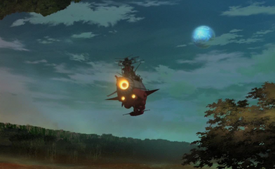
Wings extended for atmospheric flight.
The ship can also operate under a wide range of other conditions. It can fly and hover in planetary atmospheres, augmented by retractable wings stored in its midsection. It can set down and lift off from dry dock facilities, and it can take advantage of its naval battleship design and navigate on bodies of water, and to a limited extent underwater ("Toward a Sea of Stars", "Escape from the Jupiter Sphere", "The Sun Sets on Pluto", "A Choice for the Future", "The Distant Promised Land").
Yamato is also equipped with an array of other advanced technologies that support its operations. Artificial gravity is created in most areas of the ship ("Gravestone on a Frozen Field"). Two rocket anchors mounted on Yamato's upper bow can be fired to hold the vessel firmly in place and to stop its momentum; they can also be used to hold an enemy vessel for close proximity fighting ("Escape from the Jupiter Sphere", Space Battleship Yamato 2199: Odyssey of the Celestial Ark). Food and drink are
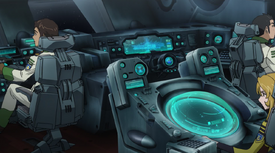
Cosmo radar and other information displays on the Yamato bridge.
primarily provided by the OMCS food processing system, which reduces the need to transport food supplies ("Point of No Return"). A hyperspace-based communication system allows for faster-than-light contact within a star system, and possibly farther if interference is not present ("Farewell to the Solar System"). Internal scanners provide information on ship status and life signs within the ship ("The Sun Sets on Pluto", "The Forever War"). External equipment can provide information on the ship's immediate surroundings out to at least fifty light seconds (approximately 15 million kilometers) with cosmo radar, as well as optical and infrared scanners ("Escape from the Jupiter Sphere", "Under a Rainbow Sun", "The Planet That We Head For"). A VLBI telescope can make long-distance astronomical observations, returning clear images of planet-sized objects from more than eight light years' distance ("Wish Upon a Star").
Locations
Bridges

The first bridge, from behind the captain's station.
Command and control of Yamato are conducted from one or more bridges placed along the ship's central vertical axis. Under most conditions, the first bridge near the top of the ship's bridge tower is used. Far more spacious than the bridge of any other Cosmo Navy vessel, dedicated science, navigation, communications, and weapons stations line the port and starboard walls, with the helm, tactical, and computer control stations plus an auxiliary station arrayed underneath a large forward-facing window. The computer station is built with a dedicated socket for the robot AU09. Cosmo radar and engineering stations are placed on either side of a dimensional compass mounted in the floor at the center of the room and ahead of the elevated captain's station. A large video monitor above the window dominates the bridge, providing scanner and communications information to the entire bridge crew. Two elevators provide access from the rear of the bridge. The bridge window can be polarized for added protection against very bright light, such as that generated by Yamato's wave motion gun ("Toward a Sea of Stars", "Escape from the Jupiter Sphere", "Point of No Return", Space Battleship Yamato 2199: Odyssey of the Celestial Ark).
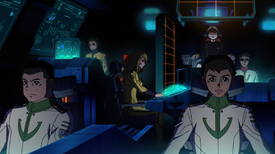
The second bridge, looking back from the helm position.
The second bridge is usually the preferred place for conducting combat operations when battle is anticipated ahead of time. Positioned just below the first bridge, the deck on which the second bridge is located is closer to the cover of the ship's anti-aircraft batteries on the bridge tower. Most significant for security, the bridge itself is enclosed in the center of the deck inside a sealed armored area away from the windows, becoming a dedicated combat information center. Crew stations are more tightly clustered, and tactical displays are arranged among the stations. The commanding officer can directly control the ship's weapons through a periscope mounted above the captain's station. Auxiliary helm and navigation stations are placed outside the armored area near the window [8] ("The Trap on All Sides", "The Sun Sets on Pluto", "The Wolf from Another Dimension").

The third bridge, viewed from outside.
Hanging below the keel is Yamato's third bridge. It features a multi-level design, with support stations placed underneath the level of the main forward stations, to maximize use of limited space.[9] The third bridge can function as a backup service area that allows direct access to the ship's wave motion shield and other engine-related functions ("Under a Rainbow Sun"). Two narrow ramps can be lowered from airlocks in the rear of the bridge module for loading and unloading of crew ("Toward a Sea of Stars").
Crew Quarters
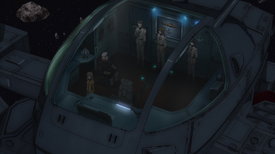
A meeting in the admiral's private quarters atop Yamato.
The captain's private quarters are placed at the very top of the bridge tower. In addition to work and relaxation space, a canopy window provides an unobstructed view of the ship's surroundings. The bed folds up to the rear wall to create a more open area for visitors. A single door leads from the room to the lower decks. The captain's chair can move along a track from the forward window across the room and down directly into the captain's station on the first bridge immediately below ("Wish Upon a Star", "Point of No Return", "The Distant Promised Land").
Senior officers are given private windowless quarters on lower decks, while junior crew members use bunks in shared cabins ("Clockwork Prisoner", "Memories of the Blue Planet", Space Battleship Yamato 2199: Odyssey of the Celestial Ark).
Landing and Launch Facilities

One of Yamato's landing bays opens.
Yamato's fighters are launched from dedicated areas of the ship. Hayabusa or Cosmo Tiger II fighters are launched from from a fighter bay in the lower rear half of the battleship; readied planes are rotated into position on alternating carousels and are released backward one at a time along a tracked ramp opening from the ship's keel, behind the main thrusters. Cosmo Zeroes take off from retractable reward-pointing catapults that are elevated from enclosed bays to the upper aft deck ("Gravestone on a Frozen Field", "The Trap on All Sides").
Other auxiliary craft and small visiting vessels use port and starboard hangars on the lower half of the main hull for take-offs and landings. A robotic arm can be used to guide arriving vessels into one of the bays and to move them out into space ("Clockwork Prisoner", "Graveyard of the Universe", "The Wolf from Another Dimension", "Under a Rainbow Sun").
During Yamato's first year of service, a single Ki-8 Stork multipurpose craft was stored inside a small private bay on the forward ventral half of the ship. The bay and the Ki-8 were hidden from the commanding officer and most of the crew by conspirators planning to seize the ship and abandon the search for Iscandar. Its existence was revealed only after the collapse of the mutiny (Space Battleship Yamato 2199: Odyssey of the Celestial Ark).
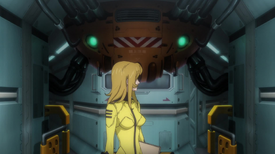
Entryway to the auto-navigation room.
Yamato's navigation through space is assisted by computers in a dedicated compartment placed ahead of the forward shock cannon turrets, near the location of the wave motion gun firing mechanisms. The room is elevated above the corridor leading to it, forming a hemispheric bulge on the ship's top deck. Personnel enter and exit via a retracting stairway[10] ("The Whisper of the Witch").
At the time of Yamato's launch in 2199, the ship headed into unknown interstellar space with little usable data, and with their primary source of information, Princess Yurisha Iscandar, in a coma. It was decided to use technology to directly access her unconscious brain and connect her to the ship's navigational system. Yurisha was placed inside a sealed medical capsule, which was transferred to the auto-navigation room prior to takeoff; knowledge of her presence was kept from all aboard but the commanding officer, the executive officer, and the chief physician ("Toward a Sea of Stars", "Out of the Forest of Memory"). The procedure was a limited success, but it became unnecessary after members of the crew discovered an intact Iscandarian star chart on the planet Beemela 4 ("A Choice for the Future"). After arriving on Iscandar, a key component of the new Cosmo Reverse System installed in the battleship was placed inside the auto-navigation room ("The Distant Promised Land").
Medical Section
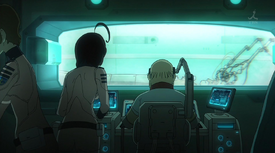
Emergency surgery.
The ship's medical section is made up of a suite of facilities capable of providing care for a wide range of health conditions. Minor ailments and injuries can be treated in a general practice area that includes scanning equipment and medicines ("The Trap on All Sides", "A World I Once Saw", "What Lies Beyond"). Major trauma cases--particularly combat casualties--are brought to a hospital area that can accommodate numerous patients ("The Sun Sets on Pluto", "Memories of the Blue Planet"). For the most critical cases requiring invasive procedures, the medical staff can conduct robotic surgery. A patient is suspended in an enclosed chamber filled with oxygenated fluid[11]; a cluster of small mobile units operated by remote control carry out procedural instructions, and transmit data to the attending staff ("The Wolf from Another Dimension"). The chief medical officer administers the medical section from a private office ("Escape from the Jupiter Sphere").
Other Locations
History
Origins
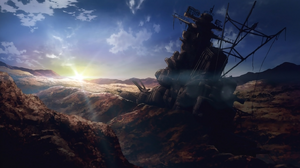
Yamato under disguise prior to its first launch.
Earth's first contact with an alien civilization in 2191, the Great Garmillas Empire, quickly turned into a war that overwhelmed its limited abilities over the following years ("Messenger of Iscandar", "A World I Once Saw", "Out of the Forest of Memory"). As the ships of the UN Cosmo Navy were outclassed by their alien opponents and as the human homeworld was turned into a radioactive desert by a ceaseless Garmillan onslaught, the leadership of the Earth Federation saw escape as the only option. Under Project Izumo, humanity would build its first interstellar spaceship and ferry a small group of survivors out of the solar system to find a new planet to inhabit. A site underneath the dry seabed of the East China Sea, off the Bonomisaki Cape of Japan, was chosen for construction. The new ship was built partially underground and partially above the surface; its exposed upper hull was disguised as the wreck of the naval battleship IJN Yamato, which sank in the area almost two and a half centuries earlier, to hide the project from enemy forces ("Messenger of Iscandar", "Toward a Sea of Stars", "A Choice for the Future").
As construction commenced on the vessel and a crew was selected, a surprise alien visitor arrived in early 2198 with information that would shake up the Izumo Plan. Princess Yurisha Iscandar presented an invitation to travel to the distant world of Iscandar and take possession of the Cosmo Reverse System, a device that would remove the radiation threatening Earth's surviving population and restore Earth's ravaged biosphere. She also offered plans for a highly advanced wave motion system to power the human ship for the round trip journey to the Large Magellanic Cloud and back. Izumo was secretly scrapped, and as part of the new Yamato Plan, the vessel was re-designed to accommodate a wave motion engine. Recognizing the incredible energies that could be generated, Major Shiro Sanada, a scientist serving in the UNCF, designed a wave motion shield for defense, along with an unparalleled weapon of mass destruction, a wave motion gun. Just as work was being completed one year later, a sister of Princess Yurisha arrived in the solar system with a wave motion core that would drive the engine. The space battleship Yamato was ready for flight, and the crew were notified of their new mission by their commanding officer, Admiral Juzo Okita, only a day prior to launch ("Messenger of Iscandar", "Toward a Sea of Stars", "Out of the Forest of Memory", "They're Coming!").
2199: Voyage to Iscandar
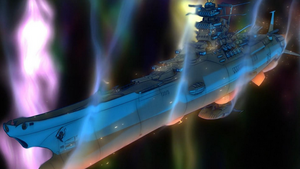
The battleship tests its warp engines.
Yamato's outbound flight through the solar system became a trial for its new technologies. Its shock cannons easily took out a Garmillan carrier and an interplanetary missile sent to destroy it before liftoff, and the wave motion shields safely deflected the missile's explosion at point blank range ("Toward a Sea of Stars"). One day later, the battleship conducted its first warp and traveled from Mars to Jupiter almost instantaneously, and at Jupiter, Yamato obliterated a massive Garmillas floating continent hidden in the gas giant's atmosphere with its wave motion gun ("Escape from the Jupiter Sphere"). A condenser failure on the main engine the very next day forced a detour to the moon Enceladus for supplies of cosmonite-90 to make repairs ("Gravestone on a Frozen Field"), but the battleship was soon ready for a full assault on Pluto. Combined with its full fighter squadron, Yamato fended off a counterattack, bombarded the main enemy base, and wiped out the Garmillas presence in the solar system ("The Trap on All Sides", "The Sun Sets on Pluto").

Yamato on the brink of defeat at Carell 163.
The ship was ready for the demands of the long mission ahead and headed out into the Milky Way Galaxy and beyond--but the Garmillans were no longer taking their human adversaries for granted. As word of the ship's successes reached the highest levels of the empire and inspired conquered worlds to defy the empire's rule, Leader Abelt Dessler grew increasingly focused on stopping it ("Wish Upon a Star", "What Lies Beyond"). Yamato was very nearly destroyed at the Battle of Carell 163, and was saved only by a surprise Garmillan withdrawal ("Point of No Return"). Delayed in reaching Iscandar and with morale lower than ever, members of the crew who had been conspiring to re-start the Izumo Plan launched a short-lived mutiny ("A Choice for the Future"). After the mutiny was put down, officers who had been exploring a nearby Earthlike planet returned with information that would save the mission: a network of ancient alien subspace gates that could trim months off Yamato's journey ("Out of the Forest of Memory"). To access the network, though, the ship would have to confront those who currently controlled it--the Garmillas Empire. Admiral Okita and his crew devised a plan to charge through the network before destroying the hub located at the planet Balun with the wave motion gun. The ship arrived safely at the far side of the network on the edge of the Large Magellanic Cloud, having not only rendered the network nearly useless, but also destroying thousands of enemy warships in the process and crippling the Garmillas military ("Over the Black Light").
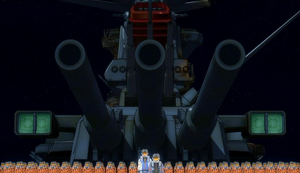
Remembering the dead.
Yamato was now seen as the single greatest threat to Dessler's empire. A particularly brutal engagement in the Rainbow Star Cluster failed to stop its progress toward Iscandar ("Under a Rainbow Sun"), and after happening upon a liberated prison world, Yamato was given drydock repairs and military intelligence from members of the Garmillan resistance movement against Leader Dessler ("Prison Planet 17", "The Planet That We Head For"). When Yamato arrived in the home star system of both Iscandar and Garmillas, Dessler attempted to take down the battleship by any means necessary, even if it meant annihilating his own capital city. During the battle, Yamato fired its wave motion gun against Dessler's attack, saving not only itself but the entire capital. In doing so, Yamato demonstrated humanity's honorable intentions, even as their own ruler proved himself a menace to his own people. Dessler was assumed to have died during the battle, and with the war having come to an abrupt end, Yamato was allowed to fly on to its destination ("One Man's War", "The Distant Promised Land").
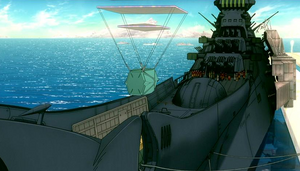
Installing the Cosmo Reverse System.
After arriving on Iscandar, the crew of Yamato learned that the ship itself may have caused the mission to fail. Queen Starsha Iscandar, having been told about Yamato's wave motion gun by Dessler and witnessing it herself during the fight over Garmillas, was horrified that her planet's technological gift had been used to create a superweapon. She refused to deliver the long-awaited Cosmo Reverse System, concluding that humanity was too dangerous to survive. However, the intervention of two people who were very close to her eventually changed her mind, and she personally brought the device to Yamato--but she demand Admiral Okita's pledge that humanity would never again create wave motion-based weapons. The firing components of Yamato's wave motion gun were removed and replaced with the Cosmo Reverse System, turning the battleship itself into the instrument of Earth's survival. The forward muzzle of the gun was sealed, and a plaque announcing a new treaty signed by representatives of Earth, Iscandar, and the Great Garmillas Empire was mounted on the muzzle cover ("The Distant Promised Land", Space Battleship Yamato 2199: Odyssey of the Celestial Ark).
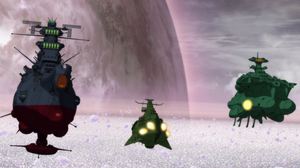
Flying into battle with new Garmillan allies.
The return voyage to Earth was much faster and less eventful, except for two major incidents. The first, occurring a month after departing Iscandar, began when Yamato was ambushed by an expeditionary fleet of the Gatlantis Empire that sought to take the ship as their own. Yamato escaped, but found itself trapped inside a region of space with seemingly no connection to the rest of the universe. On the planet at the heart of the region, Shambleau, a human landing party discovered members of a Garmillas task force that had also been trapped. Yamato and the task force cooperated and fought side-by-side after the Gatlanteans tracked Yamato to Shambleau (Space Battleship Yamato 2199: Odyssey of the Celestial Ark). The second took place one month later when Yamato attempted to reactivate the only undamaged subspace gate at Balun. The ship was hit by a surprise attack from rogue Garmillan forces and fled through the gate and into a subspace corridor--only to be seized and boarded by troops serving Abelt Dessler, still alive and intending to use Yamato to reclaim the empire for himself. After repelling the

Yamato prepares to finish its first mission.
boarding party, Yamato opened fire on Dessler's flagship with a volley of shells from its shock cannons, fatally crippling it ("The Forever War").
Yamato returned to Earth on December 8th. The Cosmo Reverser was activated almost immediately upon arrival, and Yamato turned the dying desert planet back into the watery, green world it had once been (Space Battleship Yamato 2199: Odyssey of the Celestial Ark, "Memories of the Blue Planet").
2202-2203: Terezart and the War with Gatlantis
Following the removal of the Cosmo Reverse System, Yamato's systems are upgraded and the ship is readied for new military service[5] (Space Battleship Yamato 2202: Warriors of Love).
Uniforms and Protective Gear
See Yamato uniforms and protective gear (2199) for more comprehensive descriptions. See United Nations Cosmo Navy for information on UNCN uniforms and gear not specific to Yamato.
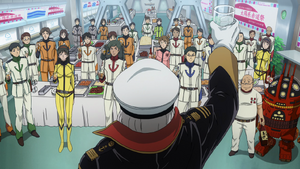
Admiral Okita and crew members from various departments share a celebratory moment.
Although the crew of Yamato retain their affiliations with the United Nations Cosmo Navy and other branches of the UNCF during the first year of service, nearly everyone is assigned uniforms that are unique to the space battleship. Basic military uniforms are decorated with UNCF rank shoulder boards, but are color coded to match department assignments, including red (tactical), green (navigation), yellow (operations), blue (science and technology), white with orange trim (engineering), orange with black trim (accounting), black with yellow trim (fighter squadron), and gray (security). Civilian medical staff feature their own variants resembling military uniforms. On top of the basic uniform, officers may wear supplemental gear, such as tool vests and bullet-proof tactical armor. Female uniforms are generally form-fitting, while male uniforms have a looser fit. Combat flight suits resemble duty uniforms. Admiral Juzo Okita, the ship's commanding officer, continues to wear a standard UNCN command-level uniform ("Toward a Sea of Stars", "Escape from the Jupiter Sphere", "The Trap on All Sides").
Other protective gear such as spacesuits and hazmat suits remain very similar to their UNCF counterparts, but often with colors corresponding to each individual's department assignment ("Toward a Sea of Stars", "Escape from the Jupiter Sphere", "Farewell to the Solar System").
Gallery
Behind the Scenes
- Unlike the original 1974 incarnation of Yamato, the space battleship was not constructed inside the wreckage of the twentieth century naval warship. This takes into account the discovery and confirmation of the IJN Yamato at the bottom of the East China Sea in the 1980s. Photos show that the ship had broken into two large separate pieces and multiple fragments scattered across the ocean floor as it sank.[12] Without a relatively intact wreck, building a large starship inside of it would have been impossible, regardless of other engineering challenges.
Notes and References
- ↑ In addition to at least twenty-four Cosmo Falcons flying into combat at the Battle of the Rainbow Star Cluster, one is shot down during Operation M-2 ("The Sun Sets on Pluto"), and one is destroyed by a reactor overload ("A World I Once Saw").
- ↑ Official Space Battleship Yamato 2199 Earth Mecha Book p. 142
- ↑ ibid p. 4
- ↑ Satoshi Koizumi, mecha designer for the Yamato 2199 series, noted in a 2013 interview with Great Mechanics DX magazine #23 that the Earth battleship Kirishima had been fitted with reflective armor coating technology acquired from Garmillas ships destroyed during the Second Battle of Mars. This coating allowed Kirishima to survive hits from enemy weapons that easily wiped out other UNCN vessels during the First Battle of Pluto. It is likely that the same technology was applied to the hull of Yamato, which survives more severe impacts during its first year of operation.
- ↑ 5.0 5.1 5.2 Official Space Battleship Yamato 2199 website ship data
- ↑ Space Battleship Yamato 2202 Volume 2 Theater Brochure
- ↑ Official Space Battleship Yamato 2199 Earth Mecha Book p. 25
- ↑ ibid pp. 48-51
- ↑ ibid, p. 51
- ↑ ibid pp. 60-63
- ↑ Admiral Okita is not fitted with a mask or any other device for supplying air during his surgery, making it likely that he was submerged in perfluorocarbon or another comparable substance that allows for liquid breathing.
- ↑ "Remains of sunken Japanese battleship Yamato discovered," Reading Eagle and Associated Press, August 4, 1985, p. D13

